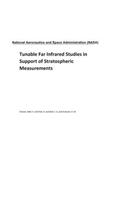
Tunable Far Infrared Studies in Support of Stratospheric Measurements
Series:
This report summarizes research done under NASA Grant NAG5-4653. The research performed under this grant has been a collaboration between institutions including the Smithsonian Astrophysical Observatory, the National Institute of Standards and Technology, the University of Oregon, and the NASA Langley Research Center. The program has included fully line-resolved measurements of submillimeter and f
NaN
VOLUME
English
Paperback

This report summarizes research done under NASA Grant NAG5-4653. The research performed under this grant has been a collaboration between institutions including the Smithsonian Astrophysical Observatory, the National Institute of Standards and Technology, the University of Oregon, and the NASA Langley Research Center. The program has included fully line-resolved measurements of submillimeter and far infrared spectroscopic line parameters (pressure broadening coefficients and their temperature dependences, and line positions) for the analysis of field measurements of stratospheric constituents, far infrared database improvements, and studies for improved satellite measurements of the Earth's atmosphere. This research program is designed to enable the full utilization of spectra obtained in far infrared/submillimeter field measurements, such as FIRS-2, FILOS, IBEX, SLS, EosMLS, and proposed European Space Agency measurements of OH (e.g., PIRAMHYD and SFINX) for the retrieval of accurate stratospheric altitude profiles of key trace gases involved in ozone layer photochemistry. For the analysis of the spectra obtained in the stratosphere from far infrared measurements it is necessary to have accurate values of the molecular parameters (line positions, strengths, and pressure broadening coefficients) for the measured molecules and for possible interfering species. Knowledge of line positions is in increasingly good shape, with some notable exceptions. The increase in position information includes research that has been performed in the present program of research on HO2, H2O, H2O2, O3, HCl, HF, HBr, HI, CO, OH, and ClO. Examples where further line position studies are necessary include hot band and minor isotopomer lines of some of the major trace species (H2O, O3) and normal lines of some triatomic and larger molecules (NO2). Knowledge of strengths is in generally good shape, since most of the lines are from electric dipole transitions whose intensities are well determi...
Price Comparison [India]
In This Series
Bestseller Manga
Trending NEWS




















